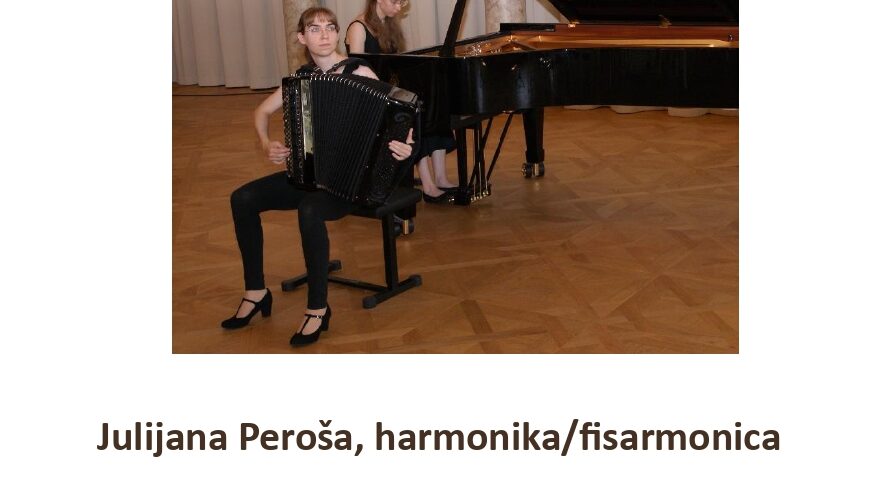Duo Accordipiano – Julijana in Katarina Peroša

Foto in video: Nastop učencev tečaja kitare
02/16/2024
Obletnica
02/16/2024
Vljudno vabljeni v soboto, 17. februarja 2024, ob 18.00 v Tartinijevo hišo na koncert DUA ACCORDIPIANO, ki ga sestavljata sestri Julijana in Katarina Peroša, študentski Akademije za glasbo iz Ljubljane.
Vstop prost do zasedbe mest.
Organizator: Skupnost Italijanov Giuseppe Tartini Piran
Duo Accordipiano sestavljata sestri Julijana in Katarina Peroša, ki obiskujeta prvi letnik magistrskega študija na Akademiji za glasbo v Ljubljani. Julijana študira koncertno harmoniko v razredu rednega profesorja Boruta Zagoranskega, Katarina, pianistka, pa se izobražuje v razredu zaslužne profesorice Dubravke Tomšič Srebotnjak.
Po končani osnovni Glasbeni šoli Koper, kjer sta obe končali osemletno izobraževanje tako harmonike kot klavirja in za izjemne dosežke prejeli Zlati violinski ključ, najvišje priznanje glasbene šole, sta se leta 2016 vpisali na Konservatorij za glasbo in balet Ljubljana, kjer je Julijana nadaljevala izobraževanje harmonike pri profesorju Klemnu Lebnu in četrti letnik zaključila pri profesorici Mariji Vukoja Plavčak, medtem pa je Katarina opravila izobraževanje klavirja v razredu profesorice Andreje Kosmač.
Po opravljeni maturi sta se vpisali na Akademijo za glasbo v Ljubljani, kjer že drugo leto igrata v duu pod mentorstvom rednega profesorja Bojana Goriška. Na koncertu iz cikla Solo e da camera februarja 2023 sta krstno izvedli triptih Fusion city, Clarity, Homesickness italijanskega skladatelja Alessia Manege, že pred tem pa sta jima svoja dela posvetila skladatelja Bojan Glavina (Štiri skladbe za harmoniko in klavir, 2011) in Igor Dekleva (Gibanja, 2017 in Con brio, 2018). Julijana in Katarina sta kot duo na mednarodnih tekmovanjih komornih skupin v Legnagu (2015), Pulju (2015, 2019, 2023), Naborietu (2019), Palmanovi (2023) in na Trophée Mondial de l’Accordéon (2023) osvojili številne najvišje uvrstitve in nagrade.
Program:
Philip Glass
Somnambulist iz opere »Les Enfants Terribles«
Uroš Rojko
Bagatele I in II
César Franck
Preludij, Fuga in Variacije
Alessio Manega
Triptih (Clarity, Fusion City, Homesickness)
Eddy Flecijn
Tri dui
Bojan Glavina
Štiri skladbe za harmoniko in klavir
(Nekega jutra, Na igrišču, Večerni sprehod, Tri male šale)
Philip Glass (1937) je ameriški skladatelj in pianist. Na splošno velja za enega najvplivnejših skladateljev poznega 20. stoletja. Glassovo delo je bilo povezano z minimalizmom, zgrajenim iz ponavljajočih se fraz in spreminjajočih se plasti.
Glass sebe opisuje kot skladatelja »glasbe s ponavljajočimi se strukturami«, ki jih je pomagal slogovno razviti.
Skladba Bagatele, delo slovenskega skladatelja, klarinetista in pedagoga Uroša Rojka (1954), je bilo napisano leta 1994 po naročilu Ministrstva za znanost in umetnost v nemški zvezni deželi Baden-Württemberg. Bagatele za harmoniko in klavir je »študija« komunikacije, ki temelji na inherentnem kontrastu med obema instrumentoma.
Preludij, Fugo in Variacije je César Franck (1822-1890), francoski skladatelj in orglavec belgijsko-nemškega rodu, po mnenju mnogih muzikologov največji orgelski skladatelj po J. S. Bachu, napisal okoli leta 1865. Sodi med njegova najbolj priljubljena dela. V izvirniku jo je skladatelj napisal za harmonij in klavir, delo pa posvetil svojima učenkama, Louise in Geneviève Deslignières.
Italijanski skladatelj Alessio Manega (1990) je študiral električno kitaro in kompozicijo na konservatoriju v Veroni ter dirigiranje na Evropski dirigentski akademiji v Vicenzi. Triptih je napisal konec leta 2022. Skladbe Fusion city, Clarity in Homesickness navdihujejo zvoki sodobne »fusion glasbe«, ki prehajajo od jazza do funka in od rocka do metala.
Rdeča nit triptiha je zlomljen in spreminjajoč se ritem, ki se zgleduje po glasbi djenta, podzvrsti progresivnega metala, za katero je značilna uporaba zapletenih in močno sinkopiranih ritmičnih vzorcev. Skladba je poklon Chicku Corei in Tigranu Hamasyanu, dvema skladateljema in glasbenikoma, ki sta uveljavila sodobno fuzijsko glasbo.
Eddy Flecijn (1962) je študiral violino in kompozicijo na Kraljevem konservatoriju v Antwerpnu, nato pa nadaljeval na Lemmensinstitutu, kjer je magistriral iz kompozicije. Kot harmonikar in bandoneonist je sodeloval v sekstetu Orquesta Atipica in Triu Vision-On.
Skladatelj Bojan Glavina je na Akademiji za glasbo v Ljubljani diplomiral iz orgel (prof. Hubert Bergant) in kompozicije (prof. Marko Mihevc). S skladanjem se je začel ukvarjati iz notranje potrebe po poglabljanju v zvočne domišljijske igre, velikokrat pa je inspiracija za nastajanje skladbe nastala iz želje, da svojim učencem napiše skladbo, s katero bi skozi zabavo in užitek napredovali pri klavirski igri. Tako so njegove skladbe, zlasti ko gre za otroški in mladinski opus, melodično in harmonsko zelo privlačne, igrive, opisne, otrokom lahko razumljive.



